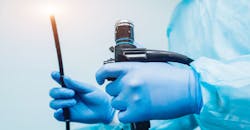Ultrasound “Lens” Could Eliminate Invasive Endoscopies
One day, cameras and endoscopes may not be needed for doctors to look down the throat, under the skin, or up the colons of patients to see the stomach, brain, or any other organs for examination, thanks to a new technique that uses ultrasound to take optical images through biological tissue. This new method, developed by Carnegie Mellon University researchers Maysam Chamanzar, assistant professor of electrical and computer engineering, and Matteo Giuseppe Scopelliti, an ECE Ph.D. student, could eliminate the need for invasive visual exams using endoscopic cameras.
Endoscopic imaging, or using cameras inserted inside the body to investigate symptoms and diagnose patients, is an invasive procedure. In many cases, the endoscopic cameras are mounted on the end of catheter tubes or wires and implanted through surgery to reach deep tissues. The new ultrasound technique is a non-surgical and noninvasive alternative.
The researchers discovered a way to create a virtual “lens” within the body using ultrasound. Carefully tailored ultrasonic wave patterns let the researchers “focus” light within the tissue, which lets them take images never before possible without using invasive means.
Biological tissue blocks most light, especially light in the visible range of the optical spectrum. Up until now, optical imaging methods did not have the light they needed to image deep tissue from the surface. Chamanzar’s lab, however, has used noninvasive ultrasound to induce more transparency to let light penetrate deeper through turbid media, such as biological tissue.
“We used ultrasound waves to sculpt an optical relay lens within biological tissue,” says Chamanzar. “Therefore, the tissue is turned into a lens that lets us capture and relay images of deeper structures.”
The researchers have shown that the properties of the virtual “lens” can be tuned by changing the parameters of the ultrasonic waves, letting users “focus” images at different depths through the medium. The researchers have yet to determine how deep within the body’s tissue this optical imaging method can reach.
“This method can revolutionize the field of biomedical imaging,” Chamanzar says.
Ultrasound waves can compress and decompress whatever medium they are moving through. In compressed regions, light travels more slowly compared to decompressed regions. The team has shown that this compression and decompression effect can sculpt a virtual lens in the target medium for optical imaging. This virtual lens can be moved around without disturbing the medium simply by adjusting the ultrasound waves from outside.
The new ultrasound imaging method could eventually be packaged in a handheld device or wearable surface patch, depending on the organs being imaged. By placing the device or patch on the skin, clinicians would be able to easily see what’s inside without endoscopy’s many discomforts and side effects. Beyond biomedical applications, the technique could also be used in machine vision, metrology, and other industrial applications for non-destructive and steerable imaging of objects and structures on the micron scale.
“What distinguishes our work from conventional acousto-optic methods is that we are using the target medium itself, which can be biological tissue, to affect light as it propagates through the medium,” Chamanzar explains.
This technique has many potential medical applications, such as diagnosing skin disease, monitoring brain activity, and diagnosis and photodynamic therapy for identifying and targeting malignant tumors. In addition, it will benefit biological research applications such as viewing healthy and diseased mouse brains and selectively stimulate different neural pathways to see what happens.

